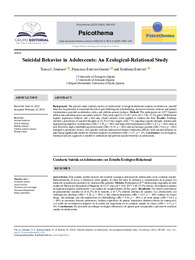Resumen :
Background: The present study analyzes factors of adolescents’ ecological-relational contexts in relation to suicidal
behavior. In particular, it examined the role of peer bullying and cyberbullying, classroom climate, violence and partner
victimization, parental socialization styles, and child-to-parent violence. Method: The participants are 2,977 Spanish
adolescents attending seven secondary schools. They were aged 11-17 (M = 14.0, SD = 1.40; 51.5% girls). Multivariate
logistic regression analyses and a two-step cluster analysis were applied to analyze the data. Results: Findings
showed a prevalence of suicidal thoughts in 43.3% of the sample, with 7.7% reporting suicide attempts. Adolescents
experiencing high/low victimization (ORa = 3.10, p < .001) and high cybervictimization (ORa = 1.67, p < .001) were at
risk. However, high cyberbullying involvement (ORa = 0.55, p < .001) and not having a partner (ORa = 0.61, p < .001)
emerged as protective factors. Sex-specific analyses underscored distinct interaction effects, with suicidal behavior in
girls being significantly related to maternal negative socialization (ORa = 1.57, p = .05). Conclusions: An ecologicalrelational
and sex approach is needed to understand and prevent suicidal behavior in adolescents. Antecedentes: Este estudio analiza factores del contexto ecológico-relacional de adolescentes en la conducta suicida.
Particularmente, el acoso y ciberacoso entre iguales, el clima del aula, la violencia y victimización en la pareja, los
estilos de socialización parental y la violencia filio-parental. Método: Participaron 2,977 adolescentes españoles de siete
centros de Educación Secundaria Obligatoria de 11-17 años (M = 14.0; DT = 1.40; 51,5% chicas). Se realizaron análisis
de regresión logística multivariada y un análisis de conglomerados de dos pasos. Resultados: Se observó prevalencia
de pensamientos suicidas en el 43,3% de la muestra, y el 7,7% informó intentos de suicidio. Los adolescentes con
victimización alta/baja (ORa = 3.10, p < .001) y alta cibervictimización (ORa = 1.67, p < .001) estaban en mayor
riesgo. Sin embargo, una alta implicación en ciberbullying (ORa = 0.55, p < .001) y no tener pareja (ORa = 0.61, p
< .001) se mostraron factores protectores. Análisis específicos de género subrayaron distintos efectos de interacción,
y el estilo de socialización negativo en la madre fue importante en la conducta suicida en chicas (ORa = 1.57, p =
.05). Conclusiones: Es necesario un enfoque ecológico-relacional y de género para comprender y prevenir la conducta
suicida en adolescentes.
|
 La licencia se describe como: Atribución-NonComercial-NoDerivada 4.0 Internacional.
La licencia se describe como: Atribución-NonComercial-NoDerivada 4.0 Internacional.
.png)
